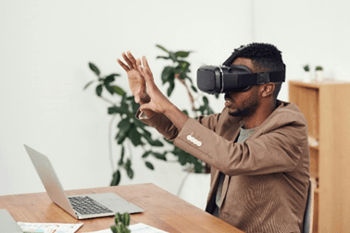AR/VR and SWIR
AR (augmented reality) and VR (virtual reality) systems have seen drastic improvements within the past few years. Augmented reality systems were first invented in the 1990s, mixing reality and digital to provide an immersive experience for users interested in entertainment and gaming industries. Since then, it has expanded to multiple industries from industrial to commercial for instance store apps have utilized AR to allow potential customers to envision how a piece of furniture may look in their home to increase buying potential. VR’s first headset was invented in the 1960s and is completely digital, allowing users to be completely immersed in a virtual world controlled by the system. It was first used for medical and flight simulations to provide training between the 1970s and 1990s but since then has reached commercial adoption into gaming and entertainment headsets. For these two systems to efficiently run, they rely on the use of AI, processing systems, lenses, and sensors.
Since AR blends reality and digital, it needs cameras to provide real-time imagery to users. Implementing SWIR (shortwave infrared) image sensors into consumer devices would greatly improve performance. Utilizing SWIR sensors will provide better imagery because SWIR’s longer wavelengths provide better contrast and details while reducing light interference. Granting the user the ability to maintain real-world visibility while using AR systems in any light setting and increased distances, providing an enjoyable experience.

VR systems are strictly digital but still rely on the use of image sensors to provide an immersive experience for users. The system currently uses image sensors to track eye movement so it can effectively respond to what the user is looking at. While current use of NIR (near-infrared) or visible sensors have the ability to track eye movement, it is not as accurate as it needs to be. Coupled with issues from bright lights hindering performance, VR headsets stand to benefit from using SWIR image sensors. SWIR has the ability to view beneath skin and other biological layers, accurately tracking eye movements. Recent VR headsets have also integrated AR systems to provide users with real-time real-world imagery such as walking down the street so that a user can comfortably navigate without having to remove their headset. To prevent walking into objects or into oncoming traffic, it is increasingly important to have the highest and fastest image quality to prevent such instances from happening.

The importance of using SWIR image sensors in AR and VR systems is to have the best user experience in any lighting condition. Oftentimes bright lights from either LEDs or the sun can cause blowouts, effecting image quality that these systems depend on. It can also be said that low-light conditions also affect performance, especially for eye-tracking. If there is lagging or an inability to generate imagery in various light conditions, users will be less likely to purchase these devices. SeeDevice’s QMOS (quantum effect CMOS) image sensor provides the perfect solution to current sensors used by AR/VR devices. Highlighting its fast integration time and dynamic range grants any AR/VR device the ability to provide real-time image data without sacrificing performance due to intense lighting conditions.



